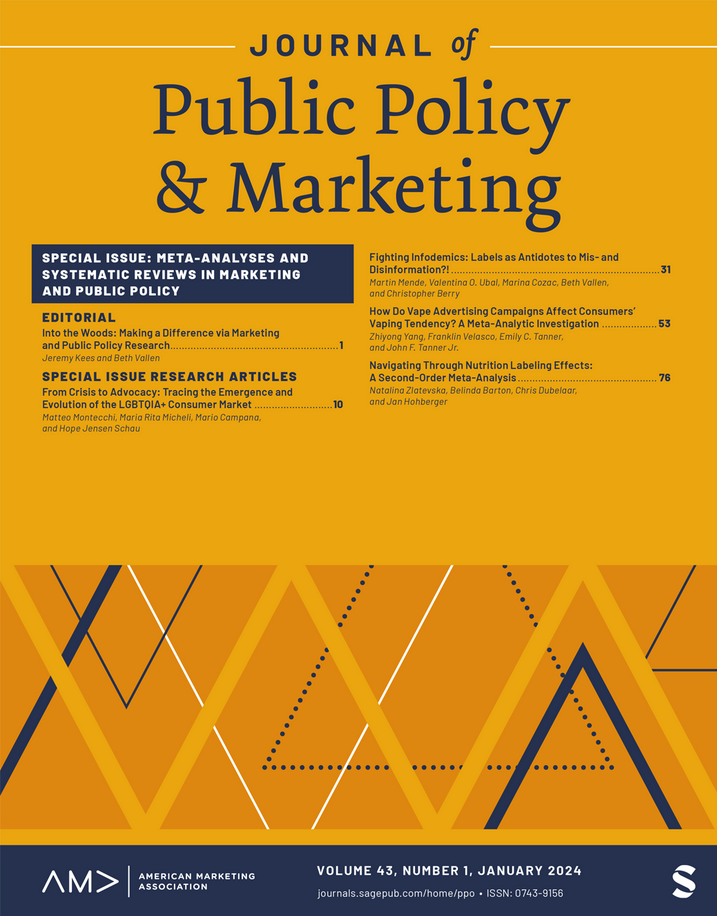Reflections on the 40th Birthday of the Journal of Public Policy & Marketing
IF 4.7
3区 管理学
Q1 BUSINESS
引用次数: 3
Abstract
The Journal of Public Policy & Marketing (JPP&M or the Journal hereinafter) was founded by Tom Kinnear of the University of Michigan in 1982 with the publication of its predecessor, Journal of Marketing & Public Policy. After the American Marketing Association (AMA) raised some concern about potential confusion with the Journal of Marketing, the Journal bore its current name from 1983 onward. The 1982 volume contained 14 articles, and the Journal was an annual publication until 1990, when it became semiannual, and in 2018 it became a quarterly publication. For a detailed review of the founding, see “In the Beginning: The Founding of the Journal of Public Policy & Marketing” (Kinnear 2011). One of the major reasons for the introducing the journal was that public policy interest by marketing academics was increasing at that time. Several marketing scholars, including Bill Wilkie, Gary Ford, Ken Bernhardt, Pat Murphy, Debra Scammon, and Josh Wiener, visited as consultants or worked at the Federal Trade Commission (FTC) and the other agencies in 1970s and early 1980s. In fact, the four editors who succeeded Kinnear all spent time at the FTC, and Kinnear did serve as a consultant to the FTC and later as a member of the National Advertising Review Board (Murphy and Wilkie 2013).These policy-oriented academics not only were major contributors to the Journal but also played an instrumental role in starting the AMA’s Marketing and Public Policy Conference and Marketing and Society Special Interest Group (Wilkie 2014). These activities were instrumental in generating interest in marketing issues related to public policy and articles for the Journal. In commemorating the 30th anniversary of JPP&M, the first seven editors reflected on their time at the helm of the Journal. Looking back at JPP&M’s early years, Kinnear noted some policy-oriented trends including children and the elderly, the environment (e.g., ecologically concerned consumers, energy use and efficiency), product liability, food labeling, and regulatory impacts on marketing (Kinnear 1982, 2011). It is interesting that many of these trends are still with us with slightly different emphases (e.g., climate change). One historical point is that the Journal appeared during the early years of the Reagan Administration, whose hallmark was deregulation. However, there was considerable academic momentum that had been building during the more activist 1970s, especially at the FTC. See Wilkie and Moore’s (2011) commentary on JPP&M’s role in advancing the study of marketing and society after 30 years. One of the topics that the current editors asked us to answer was what obstacles arose and needed to be overcome in the early years of the Journal. There were two significant ones. First was financial and administrative support. In these regards, credit is due to Alfred Edwards at the University of Michigan’s Division of Research at the Graduate School of Business Administration (now the Ross School) for support in underwriting the Journal and providing ongoing funding. At Michigan and Notre Dame, a cadre of graduate students provided the necessary person power to handle the flow of manuscripts. The administrations at both schools at the departmental and college levels were very supportive of our efforts. The second significant obstacle was to secure high-quality submissions and recruit a distinguished editorial review board. The early years required a hands-on approach by the editors to secure needed manuscript flow and quality. Both of us solicited contributions from noted scholars and encouraged reviewers to be supportive in their approach (Kinnear 2011; Murphy 2011). To have staying power, the Journal needed to be accepted as a viable outlet by both prospective authors and the academic administrators who would evaluate an author’s work. One method of increasing manuscript flow during the Murphy tenure was the institution of special issues (Murphy 1988) (more on special issues subsequently). That first reference to potential special issue papers mentioned the AIDS crisis, liability of cigarette manufacturers, and other health issues. In his 1989 editorial, Murphy (1989) added topics related to the environment, international trade, mergers, and technology on《公共政策与市场营销》创刊40周年纪念
《公共政策与市场营销杂志》(以下简称《杂志》)于1982年由密歇根大学的汤姆·金尼尔在其前身《市场营销与公共政策杂志》的基础上创立。在美国市场营销协会(AMA)提出了一些关于与《市场营销杂志》可能混淆的担忧之后,《市场营销杂志》从1983年开始使用了它现在的名字。1982年的那一卷有14篇文章,《华尔街日报》在1990年以前是每年出版一次,1990年改为半年出版一次,2018年改为季刊。关于创刊的详细回顾,请参见《一开始:公共政策与市场营销杂志的创刊》(Kinnear 2011)。创办该杂志的主要原因之一是,当时市场营销学者对公共政策的兴趣日益浓厚。包括比尔·威尔基、加里·福特、肯·伯恩哈特、帕特·墨菲、黛布拉·斯卡蒙和乔希·维纳在内的几位市场营销学者,在20世纪70年代和80年代初以顾问的身份访问或在联邦贸易委员会(FTC)和其他机构工作。事实上,接替金尼尔的四位编辑都曾在美国联邦贸易委员会工作过,金尼尔确实担任过美国联邦贸易委员会的顾问,后来又担任了美国国家广告审查委员会的成员(Murphy and Wilkie 2013)。这些以政策为导向的学者不仅是《华尔街日报》的主要贡献者,而且在启动美国医学协会的营销和公共政策会议以及营销和社会特别兴趣小组方面发挥了重要作用(Wilkie 2014)。这些活动有助于引起人们对与《华尔街日报》的公共政策和文章有关的营销问题的兴趣。为了纪念JPP&M成立30周年,前七位编辑回顾了他们执掌《华尔街日报》的时光。回顾JPP&M的早期,Kinnear注意到一些政策导向的趋势,包括儿童和老年人、环境(例如,关注生态的消费者、能源使用和效率)、产品责任、食品标签和监管对营销的影响(Kinnear 1982, 2011)。有趣的是,这些趋势中有许多仍然存在,只是重点略有不同(例如,气候变化)。一个历史观点是,《华尔街日报》出现在里根政府的早期,里根政府的标志是放松管制。然而,在更为激进的20世纪70年代,特别是在联邦贸易委员会,学术势头已经相当强劲。参见Wilkie和Moore(2011)对JPP&M在30年后推动市场营销和社会研究中的作用的评论。现任编辑要求我们回答的一个问题是,在《华尔街日报》创立之初,出现了哪些障碍,需要克服哪些障碍。有两个显著的变化。首先是财政和行政支持。在这方面,这要归功于密歇根大学工商管理研究生院研究部(现为罗斯学院)的阿尔弗雷德·爱德华兹,他支持《华尔街日报》的发行并提供了持续的资金支持。在密歇根大学和圣母大学,一群研究生提供了必要的人力来处理手稿的流动。两所学校的行政部门和学院都非常支持我们的努力。第二个重大障碍是确保高质量的投稿和招募一个杰出的编辑审查委员会。早年需要编辑亲自动手的方法,以确保所需的手稿流和质量。我们都向知名学者征求意见,并鼓励审稿人支持他们的方法(Kinnear 2011;墨菲2011)。为了保持持久力,《华尔街日报》需要被潜在作者和评估作者作品的学术管理人员接受为一个可行的出口。在墨菲任期内增加稿件流量的一种方法是设立特刊(墨菲1988)(随后更多关于特刊)。第一次提到可能的特刊文件时,提到了艾滋病危机、卷烟制造商的责任和其他健康问题。在他1989年的社论中,Murphy(1989)增加了与环境、国际贸易、合并和技术有关的主题
本文章由计算机程序翻译,如有差异,请以英文原文为准。
求助全文
约1分钟内获得全文
求助全文
来源期刊

Journal of Public Policy & Marketing
BUSINESS-
CiteScore
10.20
自引率
15.40%
发文量
29
期刊介绍:
Journal of Public Policy & Marketing welcomes manuscripts from diverse disciplines to offer a range of perspectives. We encourage submissions from individuals with varied backgrounds, such as marketing, communications, economics, consumer affairs, law, public policy, sociology, psychology, anthropology, or philosophy. The journal prioritizes well-documented, well-reasoned, balanced, and relevant manuscripts, regardless of the author's field of expertise.
 求助内容:
求助内容: 应助结果提醒方式:
应助结果提醒方式:


